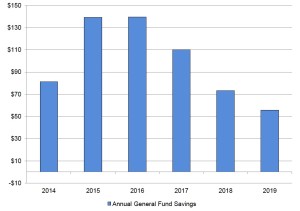November Spending Affordability Briefing: Increasing Debt Service Costs, Savings from Affordable Care Act
At its November briefing of the Spending Affordability Committee, the Department of Legislative Services urged state lawmakers to maintain current levels of debt, citing increased debt service costs in the coming years. DLS also noted that Maryland will both save money and provide more residents with health coverage due to its implementation of the Affordable Care Act (ACA).
Legislature Urged to Keep Debt at Current Levels
At the briefing, DLS analysts warned of increasing costs of debt service, the money required to pay the interest and principle on bonds that Maryland has issued. DLS forecasts that these costs will crowd out Maryland’s ability to spend money on other projects in the coming years.
The analysis and recommendation are in part a response to Governor O’Malley’s request, backed by the Capital Debt Affordability Commission, to increase debt authorizations by $75 million annually between 2015 and 2019 for the purpose of funding Maryland’s Watershed Improvement Plan.
According to the DLS, doing so will increase debt servicing costs by $43 million during this period. However, this is the result of not only increased borrowing but also a decrease in revenue from state property taxes. Property taxes, which are used to fund debt servicing, have been down as a result of the housing collapse and Great Recession, which caused housing prices in Maryland to decline for 55 months in a row. Prices have started to increase since February 2012, but because property tax revenues lag real estate market trends, DLS expects that property tax revenues will stabilize and start to increase slightly beginning in 2016.
In the meantime, debt service costs are expected to increase by 6.1 percent annually while property tax revenues are projected to increase by half a percent annually. As a result, DLS projects that beginning in 2014, an increasing amount of General Fund Revenues will be needed to pay for debt service each year.
In addition, there are more requests for funding from the capital budget than there are dollars: more than $1 billion in requests compared to just $320.4 million in unallocated funding.
DLS therefore argued that maintaining debt at current levels rather than increasing borrowing is “the remaining lever to provide relief from this ongoing fiscal squeeze” available to lawmakers.
Affordable Care Act Saving Maryland Millions
The other key theme of the November meeting of the Spending Affordability Committee was that DLS projects that Maryland will see “significant general fund savings” as a result of its implementation of the Affordable Care Act. What is most noteworthy is not just that the state will save money, but that it will do so while also providing health coverage to more residents. DLS finds that Medicaid enrollment will increase at a greater rate both because Medicaid eligibility has been expanded and because increased publicity from the Maryland Health Benefit Exchange marketing campaign is leading residents that were previously eligible but not enrolled to sign up.
General Fund Savings Attributed to the Affordable Care Act in the Medicaid Forecast
Fiscal 2014-2019
($ in Millions)
Source: Department of Legislative Services Spending Affordability Briefing, November 14, 2013.
(Click to Enlarge)
These savings are largely the result of increased federal funding to implement the ACA. Maryland’s Primary Adult Care Program will end on January 1, 2014 as the single adults currently in this program will be eligible for the expanded Medicaid program which is mostly funded by the federal government. Combined with other sources of increased federal funding for health care programs, these savings are more than enough to offset costs that Maryland will bear to implement the ACA.
Check back tomorrow for the rest of our briefing summary.

